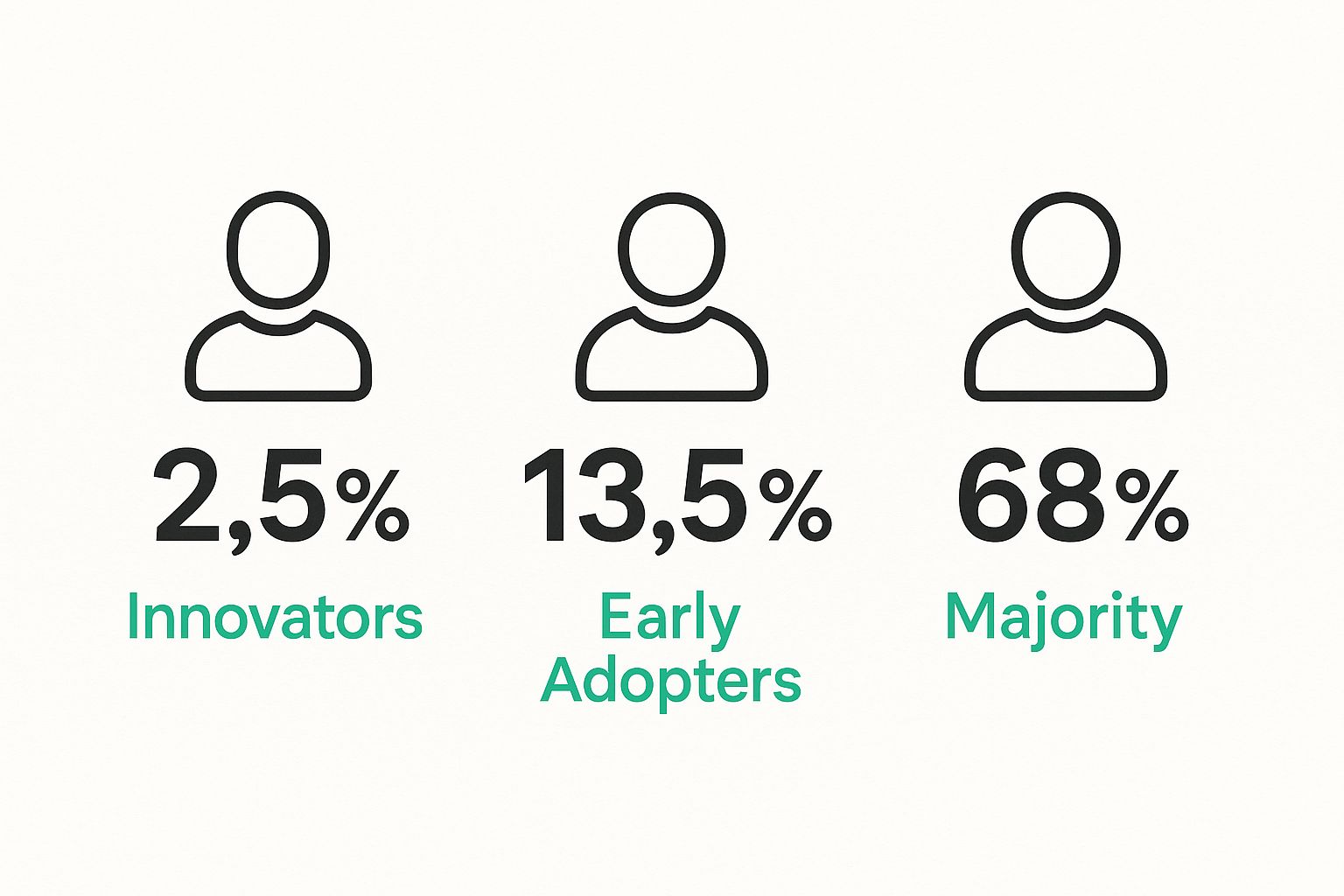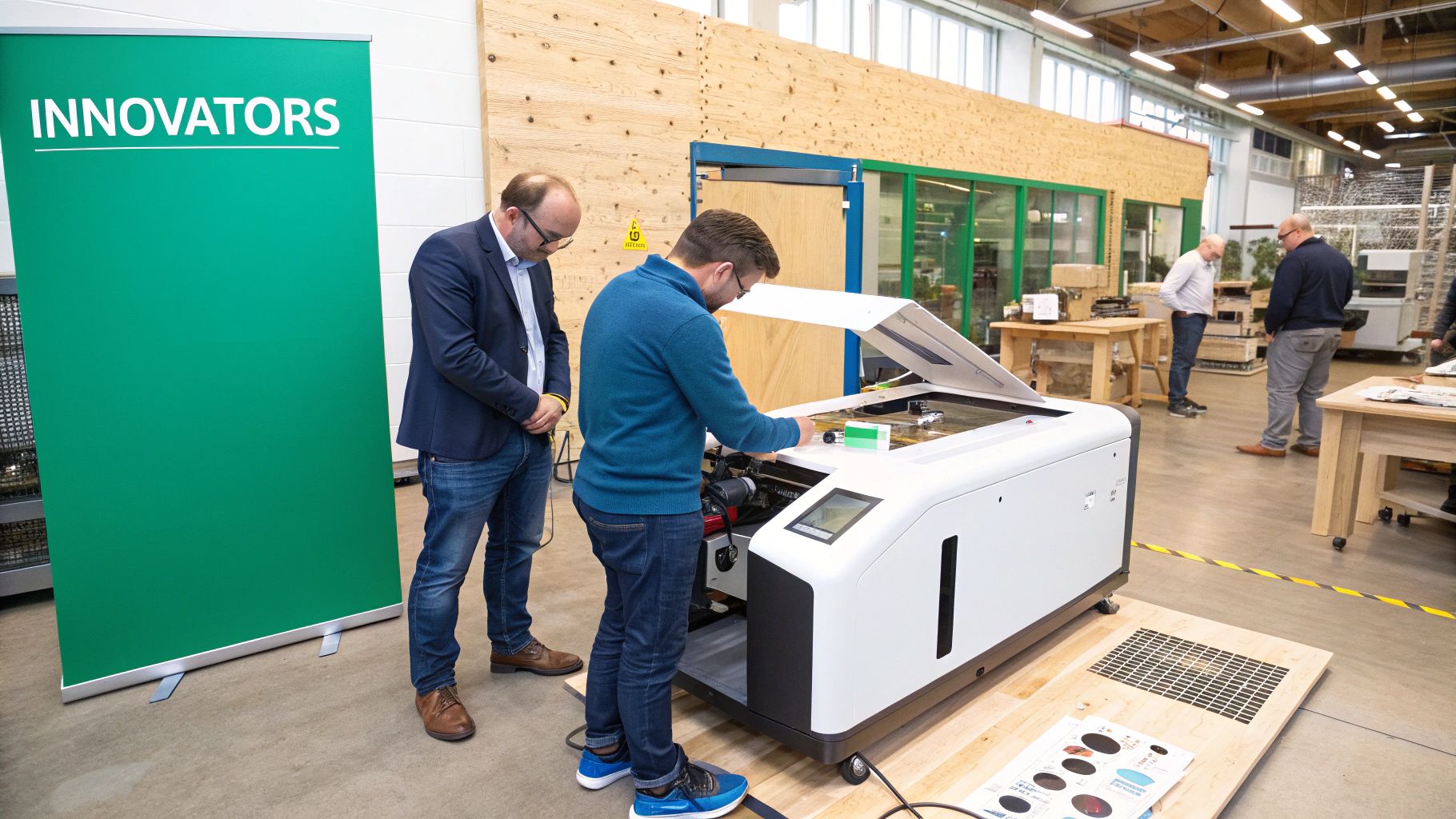Decoding the Technology Adoption Life Cycle
The Technology Adoption Life Cycle is a helpful model for understanding how people embrace new technologies. It's often visualized as a bell curve, charting the progress of an innovation from its initial introduction to widespread use. Understanding this journey is crucial for businesses, as it directly impacts the success of new products and services. The model helps predict how a technology might spread through a market and provides valuable insights into the motivations and behaviors of different adopter segments.
Understanding the Five Key Adopter Segments
The bell curve of the Technology Adoption Life Cycle is divided into five distinct groups:
Innovators (2.5%): These are the adventurous risk-takers who are the very first to try new technologies. They're driven by curiosity and the excitement of exploring the newest innovations.
Early Adopters (13.5%): Considered visionaries and opinion leaders, early adopters embrace technology ahead of the curve. They see the potential of a technology to solve problems or create exciting new opportunities.
Early Majority (34%): These are the pragmatists. They carefully evaluate a technology's benefits and reliability before adopting it. They want proof that something works before they commit.
Late Majority (34%): More skeptical and risk-averse, the late majority adopts technologies only when they've become mainstream. They're often driven by necessity or social pressure to adopt.
Laggards (16%): Resistant to change and often preferring traditional methods, laggards adopt only when absolutely necessary.
The Technology Adoption Life Cycle model uses a bell curve to show these distinct groups: Innovators (2.5%), Early Adopters (13.5%), Early Majority (34%), Late Majority (34%), and Laggards (16%). This framework, popularized in the 1960s, demonstrates how innovations like the internet and mobile phones spread. For example, U.S. internet adoption among adults grew from 52% to 90% between 2000-2019, showing the transition from Early to Late Majority. Enterprise technology trends in 2024, with cloud computing at 48%, generative AI at 36%, and applied AI at 35% adoption, demonstrate a similar S-curve progression as these technologies move from pilot programs to full implementation. You can find more detailed statistics on Whatfix.
Visualizing the Data: An Infographic Breakdown
The stats display below visualizes the distribution of adopters across the five segments of the Technology Adoption Life Cycle.

The infographic clearly shows the small percentage of Innovators (2.5%) and Early Adopters (13.5%), highlighting their importance as early testers and influencers. The larger segments of Early and Late Majority (34% each) underscore the need to reach these groups for widespread adoption. The remaining 16%, the Laggards, adopt only when necessary. These numbers are important because they illustrate the challenge of moving a technology from early adoption to mainstream use. The gap between early adopters and the early majority can be difficult to cross. Successfully bridging this gap is key to achieving widespread market penetration and long-term success for any new technology. The difference between cloud computing’s high adoption rate (48%) and the slower uptake of generative and applied AI highlights the different adoption speeds for various innovations. This underscores the importance of understanding the specific factors influencing each segment.
The S-Curve Journey: How Technologies Really Scale

The technology adoption lifecycle isn't a straight line; it's more of an S-curve. This curve illustrates the progression of technologies from initial innovation to widespread market saturation. Five distinct phases mark this journey: frontier innovation, experimentation, piloting, scaling, and mainstream adoption. Each phase presents its own set of opportunities and challenges that will ultimately determine a technology's success.
From Innovation to Experimentation: The Early Stages
The frontier innovation stage is where new technologies are born. This often happens in research labs or within small startups. Groundbreaking ideas begin to take shape. Think of emerging technologies like quantum computing or advanced biotech. These are still in their early stages, full of potential but not yet widely used.
The experimentation phase follows. Researchers and developers start testing and refining these new technologies. This stage is vital for demonstrating the viability and potential uses of the innovation.
Piloting and Scaling: Gaining Momentum
The piloting phase is a crucial turning point. Organizations begin implementing the technology in controlled, smaller-scale environments to assess its practicality and real-world effectiveness. Successful pilot programs pave the way for the scaling phase.
Scaling involves a more rapid spread of the technology. Businesses increasingly integrate it into their core operations. Cloud computing is a prime example. It transitioned quickly from pilot projects to widespread use, becoming essential to modern business infrastructure. This rapid growth characterizes the steep upward curve of the S-curve.
Reaching Mainstream Adoption: The Final Frontier
The final phase, mainstream adoption, is where the technology becomes ubiquitous. It's so integrated into daily life and business that it's almost invisible. This represents the top of the S-curve, where growth plateaus as the market becomes saturated.
Enterprise technology adoption follows this same S-curve trajectory. In 2023, technologies like generative AI and cloud computing reached scaling phases (levels 4/5), while space tech remained at stage 1. McKinsey & Company's 2024 analysis revealed that cloud/edge computing led in adoption (48%), followed by advanced connectivity (37%) and AI-driven tools.
This phased approach explains why some technologies, like electrification (which was in the piloting stage in 2023), take longer to penetrate industries than software innovations. Understanding these phases offers a valuable framework for predicting adoption timelines and creating market entry strategies. Factors such as technical complexity, infrastructure needs, and regulations influence how quickly a technology progresses through each stage.
Crossing the Chasm: The Make-or-Break Adoption Moment

This critical stage in the technology adoption life cycle determines whether a promising technology thrives or fails. It's the pivotal point between the early adopters, eager to embrace new technology for its potential, and the early majority, who need proof of practical value before committing. This gap is the infamous chasm, a concept made famous by Geoffrey Moore. Successfully navigating this chasm is the key to mainstream adoption.
Why Technologies Fail to Cross
Many innovative products never make it past early adoption. This often happens because the early majority has very different needs than early adopters. Early adopters are excited to be on the cutting edge, willing to overlook imperfections. The early majority, however, wants dependable solutions to their practical problems. They value reliability and tangible benefits.
For instance, Google Glass, while exciting for early adopters, faltered with the broader market. Its unclear purpose and privacy concerns prevented it from crossing the chasm. 3D TVs also illustrate this point. Despite initial hype, they didn't provide an experience that justified the price for the average consumer.
Strategies for Crossing the Chasm
Crossing the chasm demands a strategic shift. The focus must be on delivering a complete product experience that speaks to the practical needs of the early majority.
Target a Niche: Concentrate on a specific segment within the early majority. This focused approach allows for the development of tailored solutions that address particular needs.
Demonstrate Value: Clearly explain the technology's benefits. Show real-world applications and a clear return on investment. Case studies are crucial for showcasing successful implementation.
Build Credibility: Use testimonials from satisfied users within the target niche. This social proof builds trust and mitigates perceived risk.
Provide Support: Offer comprehensive customer support and easy-to-understand documentation. The early majority needs reassurance and help as they integrate the technology.
To better illustrate the challenges and solutions, let's take a look at the following table:
Technology Adoption Barriers Across Market Segments
This table illustrates the different barriers to adoption that exist for each segment of the technology adoption life cycle and strategies to overcome them.
| Adopter Segment |
Primary Adoption Barriers |
Purchasing Motivations |
Effective Strategies |
| Innovators |
Limited information, high risk |
Novelty, experimentation |
Direct engagement, thought leadership |
| Early Adopters |
Integration challenges, bugs |
Competitive advantage, influence |
Pilot programs, community building |
| Early Majority |
Practicality, ROI uncertainty |
Productivity, efficiency |
Case studies, proven ROI |
| Late Majority |
Complexity, social pressure |
Security, reliability |
Simplicity, guarantees |
| Laggards |
Resistance to change, cost |
Necessity, compliance |
Ease of use, affordability |
As shown in the table, each segment has distinct needs and motivations. Understanding these differences is critical for tailoring effective strategies.
Examples of Successful Chasm Crossings
Successfully navigating the chasm requires a focus on practicality, reliability, and a clear value proposition. Cloud computing is a perfect example. By addressing practical business needs like scalability and cost-effectiveness, cloud services successfully crossed the chasm and reached widespread adoption. Similarly, smartphones, initially adopted by tech enthusiasts, became ubiquitous by focusing on user-friendly interfaces and apps that addressed everyday needs.
This transition requires understanding the shifting motivations within the technology adoption life cycle. By addressing the practical concerns of the early majority, companies can bridge the chasm and achieve widespread market success. This is especially relevant for emerging technologies like AI, which are currently at this make-or-break point.
Beyond Demographics: The Real Drivers of Technology Adoption

Traditional models of the technology adoption life cycle often focus on demographic segmentation. However, recent research suggests this approach might be too simplistic. This section explores the true drivers behind technology uptake, moving beyond traditional demographic analysis.
The Limits of Demographics
While demographics can provide some initial insights, they don't fully capture the complexities of technology adoption. Knowing someone's age or income doesn't guarantee they'll embrace a new software platform. Other factors are at play.
Relying solely on demographic data can misdirect marketing efforts and lead to inaccurate adoption predictions. A more nuanced understanding of user motivations is essential for success.
The technology adoption life cycle model itself has faced criticism. Early frameworks often presented a normal distribution curve, but real-world adoption patterns are more varied.
For instance, U.S. cell phone adoption neared saturation by 2019, while global rates varied significantly. AKF Partners Growth Blog delves deeper into this topic. Additionally, 2024 data from McKinsey reveals how AI adoption differs drastically between industries, often due to cost and regulatory factors.
Utility vs. Enthusiasm: The Two Key Drivers
Beyond demographics, two primary user types drive market acceptance: pragmatists and enthusiasts. Pragmatists prioritize utility. They focus on practical benefits and ask, "How does this technology solve my problems?" They're less interested in the technical intricacies. A pragmatist might adopt a new project management tool like Asana if it demonstrably improves team efficiency.
Enthusiasts, on the other hand, are driven by technical curiosity. They embrace new technologies for the novelty itself, often experimenting with new features and providing valuable developer feedback. This group might adopt a new coding language like Rust simply out of interest, regardless of its immediate practical use.
Tailoring Strategies for Each User Type
Understanding these distinct user groups is critical for effective marketing and product development. Pragmatists respond well to messages highlighting practical benefits, cost savings, and ease of use. Clear, concise demonstrations showcasing value are key. For example, demonstrating how a CRM system automates tasks and saves time will resonate with this group.
Enthusiasts, however, are drawn to technical specifications, innovative features, and the opportunity to be involved in something new. They appreciate detailed explanations and chances to contribute to a technology's evolution. Offering early access to beta versions or engaging them in community forums can be highly effective. This nuanced approach helps bridge the gap between early adopters and the mainstream market.
Industry Battlegrounds: Where Adoption Truly Happens
Technology adoption isn't a one-size-fits-all process. Each industry has its own unique characteristics that influence how quickly and easily new technologies are embraced. Understanding these nuances is key to predicting and even shaping how technology takes hold in different sectors.
Sector-Specific Adoption: A Closer Look
The same technology can experience vastly different adoption rates across various industries. For instance, the healthcare sector might lag behind the finance industry in adopting cloud computing due to stringent patient data privacy regulations. This highlights the importance of considering the specific circumstances surrounding technology implementation.
To better illustrate the varying adoption stages, let's look at the following table:
Current Technology Adoption Stages by Industry
| Technology |
Financial Services |
Healthcare |
Manufacturing |
Retail |
Adoption Stage |
| Blockchain |
Early Majority |
Early Adopter |
Late Majority |
Innovators |
Varies widely |
| AI |
Late Majority |
Early Majority |
Early Adopter |
Early Adopter |
Rapid growth in some sectors |
| IoT |
Late Majority |
Early Majority |
Majority |
Early Adopter |
Steady progression |
This table provides a snapshot of how different sectors are embracing key emerging technologies. As you can see, the adoption stage can vary significantly, demonstrating the importance of industry context. For example, while financial services are leading in AI adoption, healthcare is cautiously exploring its potential due to regulatory concerns.
Case Studies: Blockchain, AI, and IoT
Examining specific technologies offers a more granular understanding of how industry context shapes adoption. Blockchain, with its secure transaction capabilities, has found a natural fit in manufacturing supply chains. However, challenges with integrating older systems and ensuring different blockchain platforms can communicate effectively have slowed widespread adoption.
Artificial intelligence (AI) offers incredible promise for healthcare diagnostics. Yet concerns surrounding data privacy, potential bias in algorithms, and the need for regulatory approvals have tempered its adoption in this sector. In contrast, the financial services industry has readily adopted AI for tasks like fraud detection and algorithmic trading.
The Internet of Things (IoT), with its network of connected devices, has transformed manufacturing processes. Real-time data from connected machinery empowers businesses to optimize production and implement predictive maintenance. However, security vulnerabilities and the sheer volume of data generated present ongoing adoption challenges.
Regulatory Landscapes and Competitive Dynamics
Regulations heavily influence technology adoption. Highly regulated industries, such as healthcare and finance, must navigate strict compliance requirements, potentially hindering the adoption of certain technologies. Conversely, less regulated sectors like retail often experience faster adoption rates.
Competition also fuels technology adoption. In highly competitive markets, companies may adopt new technologies to gain an edge. This can accelerate the overall adoption rate within a given industry.
Structural Elements and Adoption Rates
The inherent structure of an industry also plays a role in technology diffusion. Industries with complex supply chains or intricate internal processes often face greater challenges integrating new technologies, leading to slower adoption. Simpler industry structures can facilitate more seamless technology integration. It's crucial to benchmark your company's adoption progress against direct competitors for a more relevant comparison than relying on general technology trends.
Accelerating Adoption: Making Change Stick
This section explores practical strategies to speed up technology adoption within your organization. We'll use insights from successful transformation leaders to highlight proven methods for navigating the technology adoption life cycle.
Overcoming Resistance and Building Momentum
One of the initial challenges in technology adoption is resistance to change. This can take the form of skepticism, fear of the unknown, or simply a preference for familiar methods. Addressing these concerns requires a multifaceted strategy.
Clear Communication: Explain the reasons behind the change. Highlight how the new technology will improve workflows, rather than just listing its features. For instance, explain how new software will boost team efficiency or reduce manual tasks, instead of just describing its functions.
Early Involvement: Engage key stakeholders early in the process. This promotes a sense of ownership and reduces potential pushback later.
Targeted Training: Offer customized training that meets specific user needs and skill levels. This empowers users and reduces anxiety around adopting the new technology.
Designing Effective Pilots: Setting the Stage for Success
Pilot programs are essential for demonstrating a technology’s value and addressing any issues before full implementation.
Representative Sampling: Choose pilot participants who reflect the eventual user base. This guarantees the pilot provides relevant data and actionable insights.
Measurable Objectives: Define clear, measurable objectives for the pilot program. This enables objective evaluation and informs future implementation choices.
Iterative Approach: Use an iterative approach, incorporating feedback from the pilot to refine the technology and its implementation plan. This constant improvement cycle ensures a smoother transition for the entire organization.
Scaling Successfully: Expanding Reach and Impact
Scaling a technology successfully takes more than technical expertise. It requires a comprehensive strategy that considers both technical and human aspects.
Executive Sponsorship: Secure support from senior leadership. This generates top-down support and provides the resources necessary for successful implementation.
Change Management Practices: Implement change management practices to address the psychological and organizational effects of the new technology. This might include consistent communication, feedback channels, and robust support systems.
Metrics that Matter: Track key metrics that accurately reflect adoption success, such as user engagement, productivity improvements, or cost savings. This data-driven approach provides a clear picture of the technology’s impact and guides further refinement.
Building a Culture of Adoption
Ultimately, accelerating technology adoption means fostering a culture that embraces change and innovation.
Recognizing and Rewarding Early Adopters: Celebrate the successes of those who readily adopt the new technology. This creates positive reinforcement and encourages others to follow their lead.
Continuous Learning: Promote continuous learning and development focused on the new technology. This helps users stay current with the latest features and best practices.
Feedback Loops: Establish feedback loops to allow users to share their experiences and suggestions. This builds a sense of ownership and allows the technology to continuously evolve based on user needs.
This structured method, which prioritizes both technical function and the human factor, allows organizations to accelerate technology adoption and achieve significant results. This aligns with IndieMerger’s goal of empowering founders to build their startups more efficiently. Connecting with the right co-founder can accelerate your startup's technology adoption and overall growth. Explore IndieMerger today and find your perfect co-founder match.